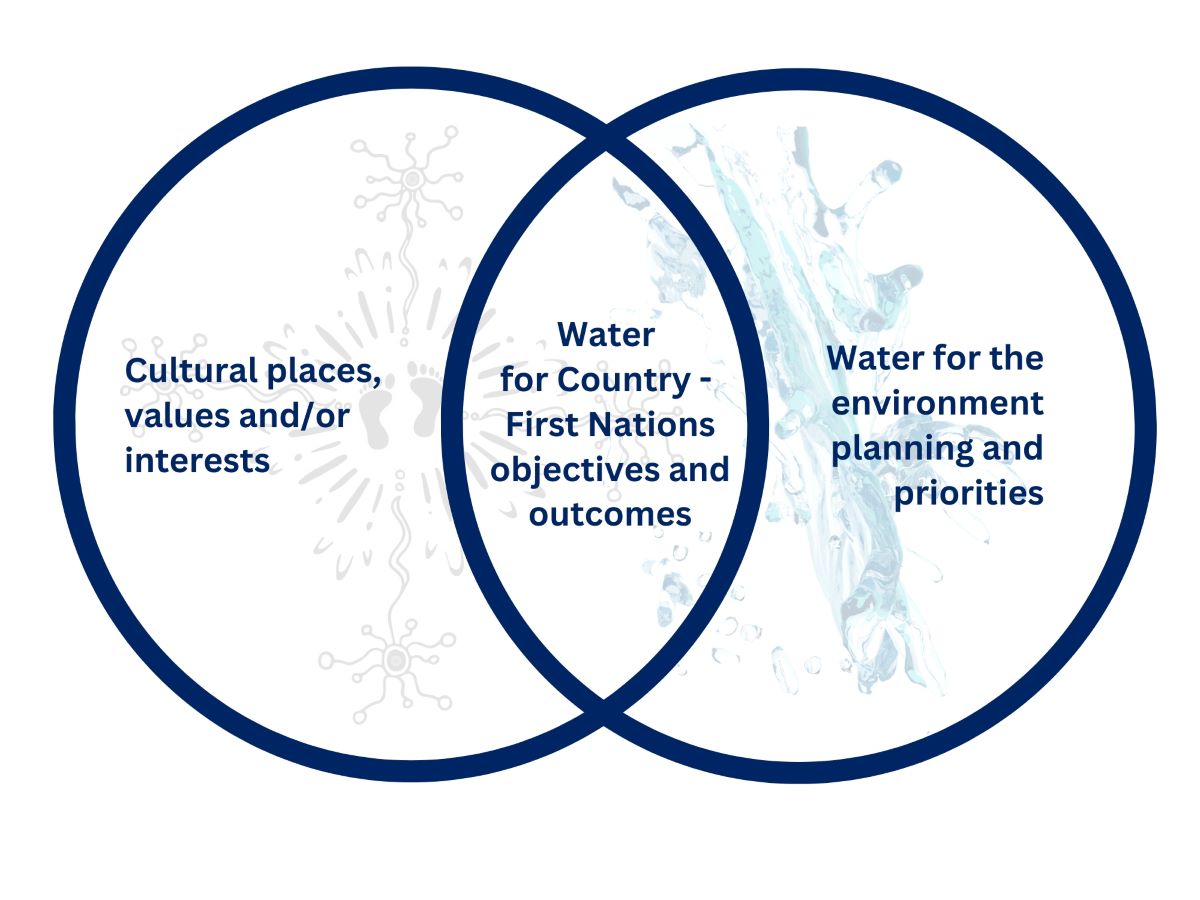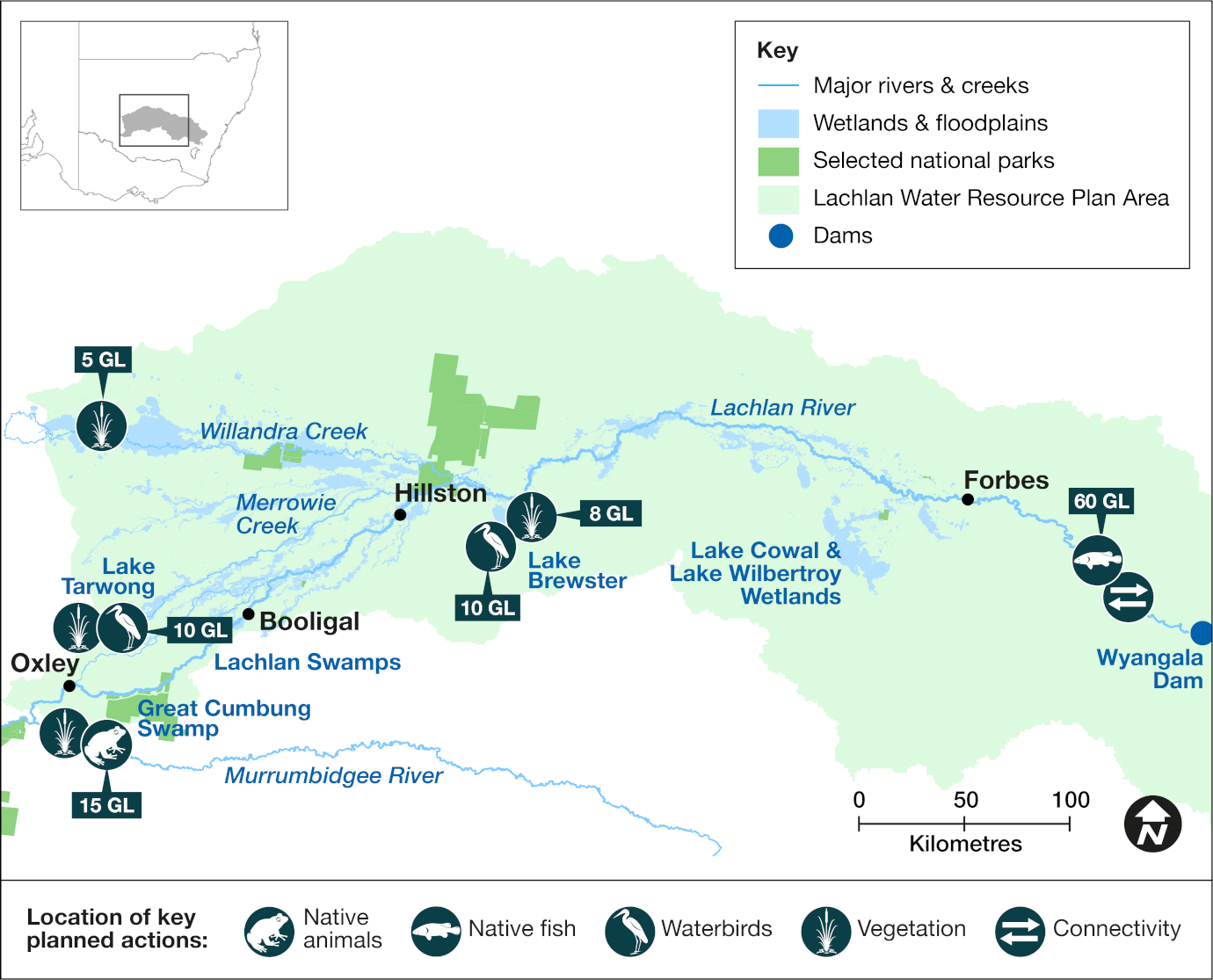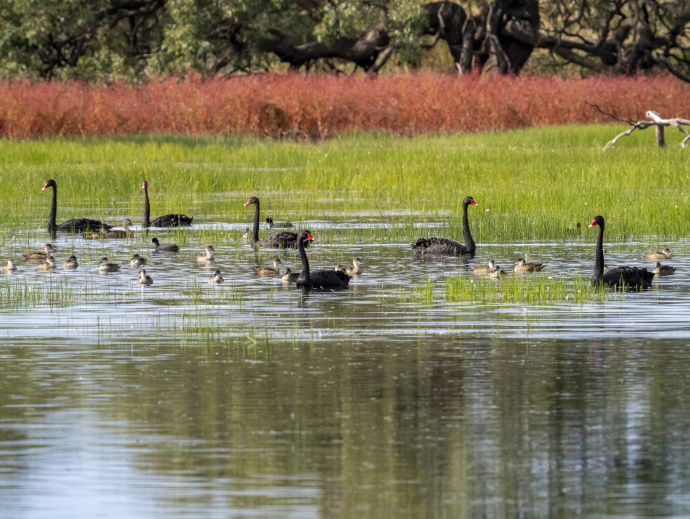Water that is allocated and managed specifically to improve the health of rivers, wetlands and floodplains is known as water for the environment.
Our environmental water management teams work with local community advisory groups including landholders, Aboriginal stakeholders, partner agencies and other interested community members to develop detailed annual plans for the use of water for the environment in each catchment, including how its use is prioritised.
Water for rivers and wetlands
The Lachlan catchment experienced increasingly wet conditions from 2021 to 2023, with major flooding following a record release of 230,000 megalitres in one day from Wyangala Dam in November 2022.
Throughout the 2023–24 water year, water managers used water for the environment to support the only significant pelican breeding event in the Murray–Darling Basin at Lake Brewster. Refuge and recovery flows were delivered throughout summer and autumn after blue-green algal issues arose in the lower Lachlan River, including a large whole-of-system fresh from Wyangala Dam.
In planning for 2024–25, water managers have applied:
- a set of principles and triggers to guide the watering of key water-dependent biodiversity assets
- an adaptive approach to support native fish and downstream ecological connectivity.
Measures are in place to provide water for any unforeseen water demands, such as waterbird nesting and water quality issues.
The Department of Climate Change, Energy, the Environment and Water (the department) may also set aside water for use in future years to support the longer-term resilience of the catchment through drier times.
Partnering with Aboriginal peoples

Environmental water managers have been working to support Aboriginal people’s priorities in water management.
Water for Country is environmental water use planned by the department and Aboriginal people to achieve shared benefits for the environment and cultural places, values and/or interests.
In 2024–25 we will partner with Aboriginal peoples and organisations in the Lachlan. This includes new and existing programs to consider Aboriginal rights and values in environmental water planning, delivery and monitoring. For example:
- the review and update of the Lachlan Long-Term Water Plan draws on local, traditional and scientific knowledge
- the Lachlan Regional Aboriginal Water Committee
- working with Canberra University on the Flow-MER 2.0 long-term monitoring program to strengthen Aboriginal peoples’ role in monitoring on-Country outcomes
- continuing to work with the Ngiyampaa Nation to support important cultural sites and lands where there is a connection to place
- Nation planning with the Condobolin Wiradjuri community for Murie Creek
- Nation planning with Wiradjuri, Mutthi Mutthi, Yita Yita and Nari Nari in the Great Cumbung regional water management plan.
Weather and water forecast
As of June 2024, the El Niño–Southern Oscillation outlook is neutral. That is, neither La Niña nor El Niño conditions are favoured as oceanic and atmospheric indicators have returned to neutral levels. International climate models suggest neutral El Niño–Southern Oscillation conditions will persist through the southern winter, but there are some signs that La Niña conditions could form later in the 2024–25 water year.
Wyangala Dam storage capacity is expected to remain high (>85%) at the start of the water year, leading into the winter storage inflow and low irrigation demand period. Environmental water accounts remain full. If La Niña conditions occur in winter, translucent and airspace or flood management releases at Wyangala Dam are anticipated. La Niña can be a very short, marginal spring event, often followed by a very hot and dry summer.
Water managers have prepared watering plans that consider a range of weather and water availability scenarios. This is known as resource availability scenario planning.
Resource availability scenario
This table provides details about how we plan for different resource availability scenarios. Wet to very wet conditions are forecast for the Lachlan catchment in 2024–25, which means water availability planning will follow the ‘wet to very wet’ scenario.
Current forecast: Wet to very wet
| Conditions | Main aim | Other aims |
|---|---|---|
| Very dry | Protect | Avoid critical loss Maintain key refuges Avoid catastrophic events |
| Dry | Maintain | Maintain river functioning Maintain key functions of high priority wetlands |
| Moderate | Recover | Improve ecological health and resilience Improve opportunities for plants and animals to breed, move and thrive |
| Wet to very wet | Enhance | Restore key floodplain and wetland linkages Enhance opportunities for plants and animals to breed, move and thrive |
Key planned actions for 2024–25
Native fish
Up to 20 gigalitres (GL) in flows are planned to provide suitable nesting conditions for Murray cod in the Lachlan River. Two GL of these flows will be used to maintain permanent refugia for the newly discovered (in April 2023), Booligal population of the threatened olive perchlet in Merrowie Creek. Delivering flow pulses or ‘freshes’ will provide food, habitat, and refuge from poor water quality throughout the year.
Waterbirds
If needed, up to 10 GL will be managed through spring and autumn to provide core breeding, foraging and migratory wader habitats. Water managers will make up to 10 GL of additional water available to support bird breeding events, such as the pelicans at Lake Brewster.
Vegetation
Water managers will focus on successive waterings of floodplain vegetation to build on condition recovery and support recruitment of:
- lignum shrublands in Merrowie Creek, Box Creek and Willandra Creek (15 GL)
- phragmites, reed beds and river red gum woodland in the Great Cumbung Swamp (up to 15 GL).
Additional volumes of up to 8 GL will promote seed setting and establish inflow and outflow wetlands at Lake Brewster. These sites will contribute to waterbird and connectivity outcomes.
Connectivity
Water managers may use up to 60 GL across the catchment to provide connectivity by enhancing large natural overbank and wetland flows, including translucent flow releases and airspace management.
Map of proposed annual priority targets in the water resource plan area 2024–25

Map of the Lachlan catchment area showing priority targets and volumes of environmental water to be delivered in 2024-25.
The Department of Climate Change, Energy, the Environment and Water delivers water for the environment where and when it is needed to support the health and resilience of rivers and wetlands. We use the best available science, management expertise and experience to manage water across the landscape. This statement of annual priorities identifies the waterways and wetlands that are likely to receive water.
Our decision-making process considers:
- expected availability of water in the coming year
- conditions of the previous year
- current health of the plants and animals in these ecosystems.
Water for the environment delivers benefits for communities, rivers, wetlands and wildlife across New South Wales.
Healthy, connected rivers and floodplains are a focus for tourism, fishing, recreation and relaxation. Rivers carry water to our homes, schools, farms and businesses, and along the way, support countless species including native fish, waterbirds, frogs, plants and more.
Rivers and wetlands have great cultural and spiritual significance for Aboriginal people.
Water for the environment is a critical tool to maintain and enhance the rivers, wetlands and wildlife we all love.
Working with communities
Local communities are at the heart of everything we do.
We involve the broader community by holding site tours and forums, and online and in-person events.
Our local water management teams consult regularly with community-based environmental water advisory groups.
Environmental water advisory group members include local landholders, recreational fishers, Aboriginal people and local government representatives. Their advice informs the decisions made by our local environmental water management teams.
Planned environmental water
| Source | Maximum volume available (gigalitres) | Volume expected 1 July under current conditions (gigalitres) |
|---|---|---|
| Water quality allowance | 20 | 20 |
| Wyangala environmental water allowance | 10 | 10 |
| Lake Brewster environmental water allowance | 10 | 10 |
| Translucent flows | Up to 350 | Depends on significant inflows to reach triggers |
Water licenced to New South Wales
| Source | Maximum volume available (gigalitres) | Volume expected 1 July under current conditions (gigalitres) |
|---|---|---|
| General security | 37.5 | 37.5 |
| High security | 1.8 | 1.8 |
Water licenced to the Commonwealth
| Source | Maximum volume available (gigalitres) | Volume expected 1 July under current conditions (gigalitres) |
|---|---|---|
| High security | 0.9 | 0.9 |
| General security | 87 | 87 |
Notes: This is an indicative summary of expected volumes to be available. For further detail and information on available volumes you can contact the region via the Department of Climate Change, Energy, the Environment and Water on 1300 361 967.
1 gigalitre = 1000 megalitres; 2.5 megalitre = 1 Olympic swimming pool.
Water for the environment has been delivering outcomes for rivers, wetlands and wildlife for 30 years.
We deliver flows that:
- trigger native fish to breed and move
- support waterbirds to nest and feed
- connect rivers and floodplains
- water forests and floodplains
- allow plants to grow, flower and set seed
- create refuge during droughts
- enhance outcomes during wetter times
- release vital nutrients from the floodplain floor that underpin the aquatic food web.
It’s habitat restoration on a landscape scale.

More information on planned and past watering events
- Annual environmental water priorities in the Lachlan catchment 2023–24
- Annual environmental water priorities in the Lachlan catchment 2022–23
- Lachlan Catchment – Water for the Environment: Annual Priorities 2021–22
- Lachlan catchment: Annual environmental watering priorities 2020–21
- Water for environment outcomes 2022–23
- Water for environment outcomes 2021–22
- Use of water for the environment in NSW: Outcomes 2020–21